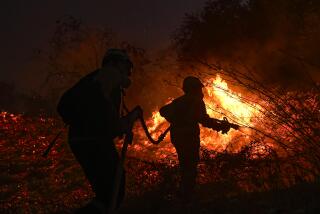Arctic sea ice melts to near-record lows
- Share via
A blistering summer melted Arctic sea ice to near-record lows, a trajectory that scientists say could reduce ice coverage in the polar region to its lowest since satellite measurements were first taken in 1979.
That’s the grim assessment delivered Thursday by the National Climatic Data Center, which also calculated that global temperatures last month made it the eighth-warmest August on record, part of a general warming trend.
The ice melt in August was the second-most extensive, and with a few more weeks left of melting, it’s possible that the record lows of 2007 could be matched, according to Jake Crouch, a climate scientist with the National Oceanic and Atmospheric Administration.
Measurements show Arctic ice covering 1.67 million square miles, well below the average minimum of 2.59 million. Scientists monitor the summer ice melt to gauge the effects of human-caused global warming. Some computer models predict the Arctic could be ice-free by midcentury.
Thursday’s report also underscored increasingly wild weather patterns. The U.S. experienced weather-related disasters that caused $10 billion in damage during 2011, another record. With the hurricane season underway, that number could rise, Crouch said.
Federal forecasters also predicted a return to La Nin?a conditions, bringing slightly drier and warmer weather to much of the country.
Heat and aridity records were beaten across the United States this summer, where every state except North Dakota and Vermont reported at least one day of 100-degree readings. It was the nation’s second-hottest August on record.
Texas was hit the hardest, beset by prolonged drought, wildfires and excessive heat. In the panhandle town of Wichita Falls, 88 of 92 days this summer exceeded 100 degrees.
Texas state climatologist John Nielsen-Gammon has said preliminary estimates for the economic effect of the drought on the state’s agriculture and livestock industry is $5.2 billion, and the cost of the fires is nearly $2 billion.
There’s been little relief. An average of 10 inches of rain has fallen across the state in the last 11 months, Nielsen-Gammon said. If Texas does not receive 31/2 inches of rain in the next two weeks, 2011 will go in the record books as the state’s driest year ever.
More to Read
Sign up for Essential California
The most important California stories and recommendations in your inbox every morning.
You may occasionally receive promotional content from the Los Angeles Times.














